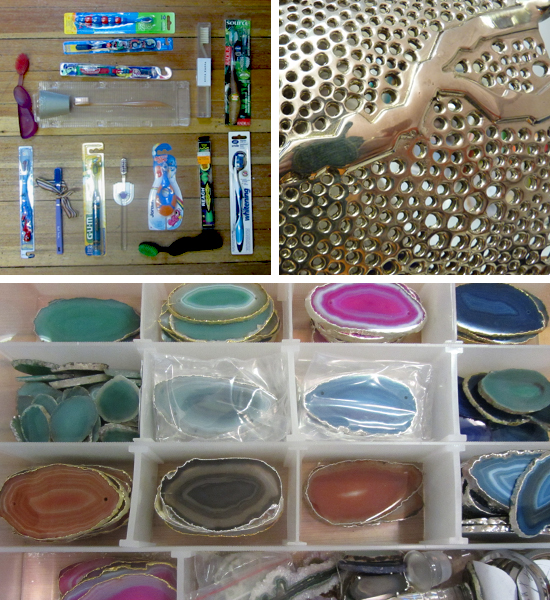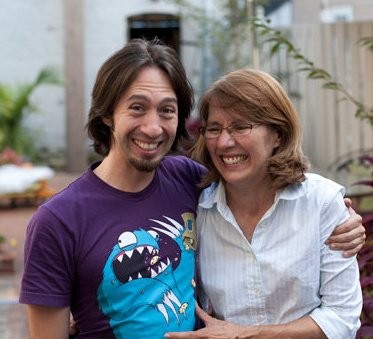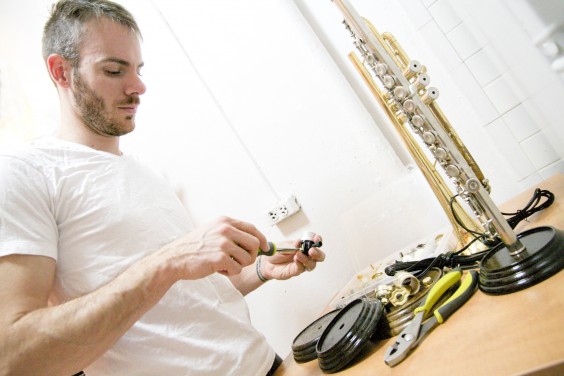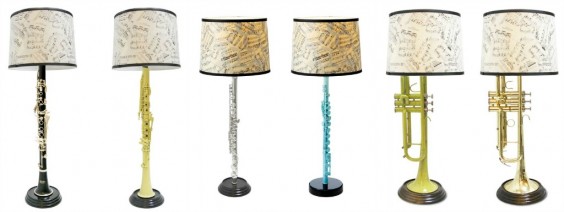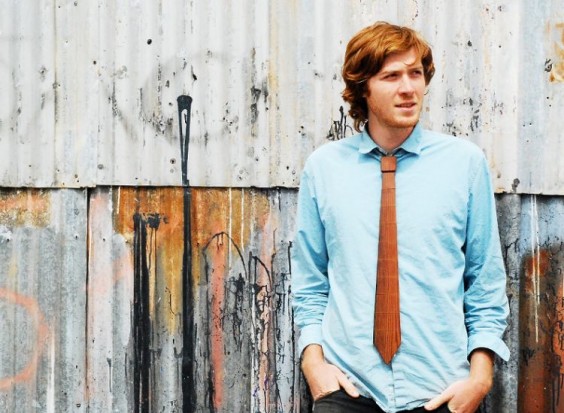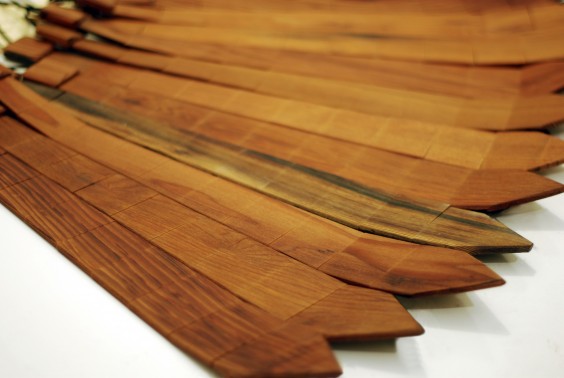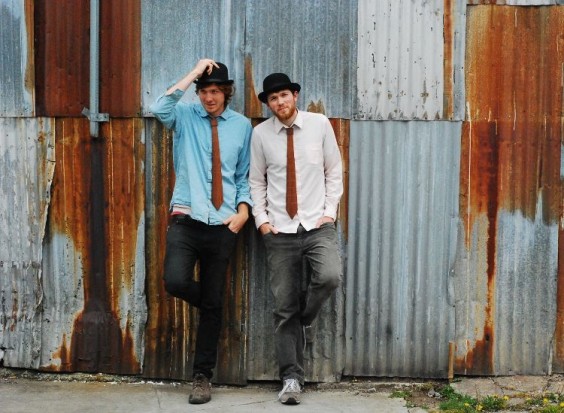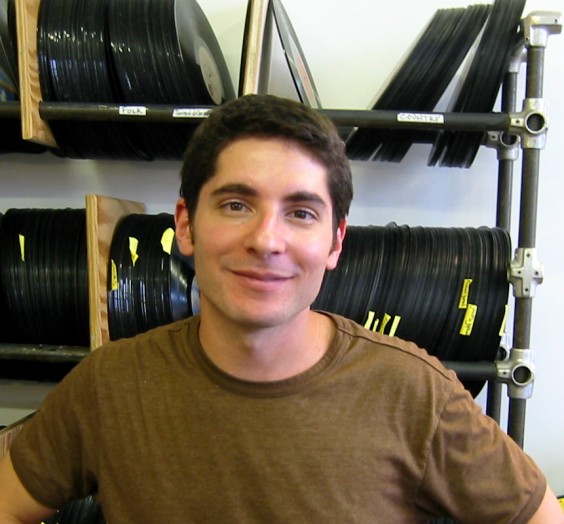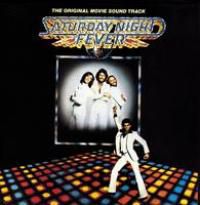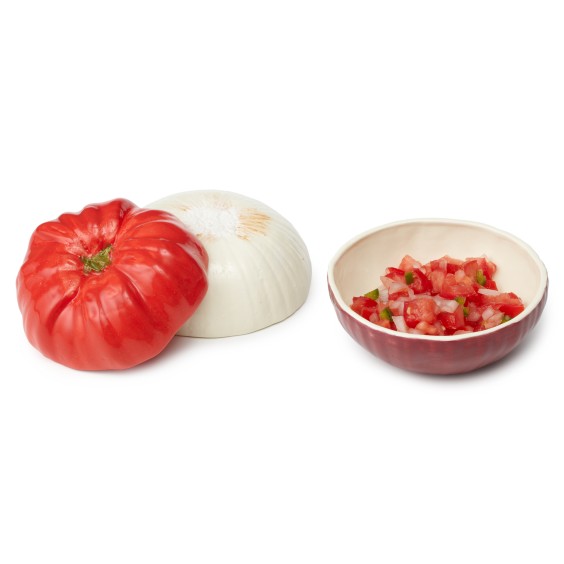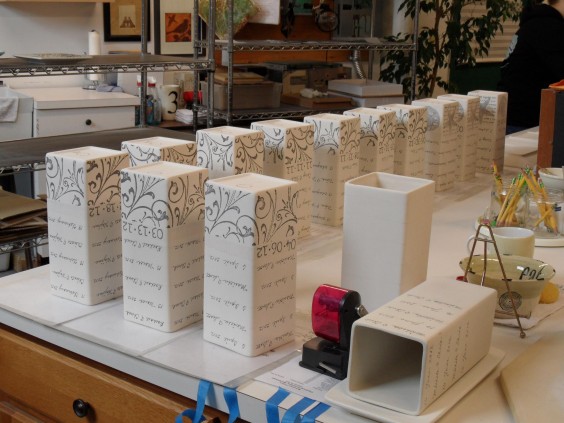
Jill hand-letters cursive wedding dates onto custom vases at her studio in New Hampshire.
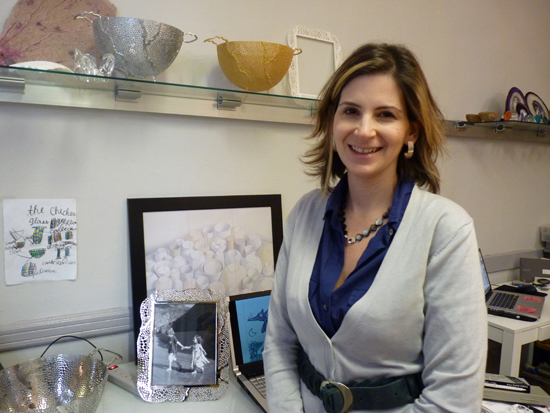 We want to give you an exclusive look inside the workspaces and minds of our uncommon artists. The very first designer’s studio tour features Anna Rabinowicz of RabLabs, the artist behind our Agate Coasters Set. Anna has been in her Flatiron studio for more than two years, a space that she shares with her team and another artist. Always fascinated with stones, Anna was able to start her own business when an opportunity came up with a distributor in Brazil. In addition to running her own business, Anna teaches product design, sharing her deep knowledge of geology and agate formation, with students at the Parsons School of Design.
We want to give you an exclusive look inside the workspaces and minds of our uncommon artists. The very first designer’s studio tour features Anna Rabinowicz of RabLabs, the artist behind our Agate Coasters Set. Anna has been in her Flatiron studio for more than two years, a space that she shares with her team and another artist. Always fascinated with stones, Anna was able to start her own business when an opportunity came up with a distributor in Brazil. In addition to running her own business, Anna teaches product design, sharing her deep knowledge of geology and agate formation, with students at the Parsons School of Design.
What is a typical day in the studio like?
In the morning I could be working on designs and Skyping with manufacturers across the world, and then heading to Parsons in the evening to conduct a lecture. In between, I may get a visit from my two young children (Izzy, 4 and Talia, 2), one of the benefits of keeping a studio close to home.
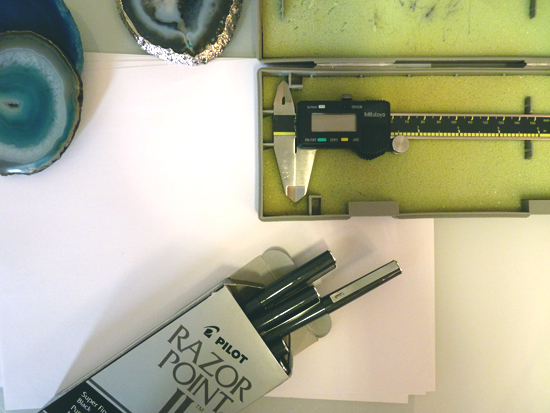
What are your most essential tools?
The Pilot Razor Point II pens are the world’s most amazing pens. I’m very particular about the pens that I use for drawings and their very precise line makes a big difference. I only draw in black pen because it forces me to make design decisions. I prefer to draw on typing paper; if I want to make revisions, I just put another piece of typing paper on top to create a trace over.
My other essential tool is my digital caliper. It helps me to measure things in a really accurate way. For example, I can check the parts that we receive from manufacturers, to make sure that the dimensions are correct. It was a gift from my father when I was in grad school and is one of my most prized possessions!
Where do you find inspiration within the studio?
I am very inspired by the artifacts that we keep sitting around, like the pieces of sea fan and rocks, and the prototypes that I have created. I learn so much about what the final product will look like from the models that I create….like a model made of clay molded around a tiny metal bowl, with natural crystals attached at interesting angles….this piece ultimately became a bowl based on the morphology of natural crystals, which will be produced in lead crystal.
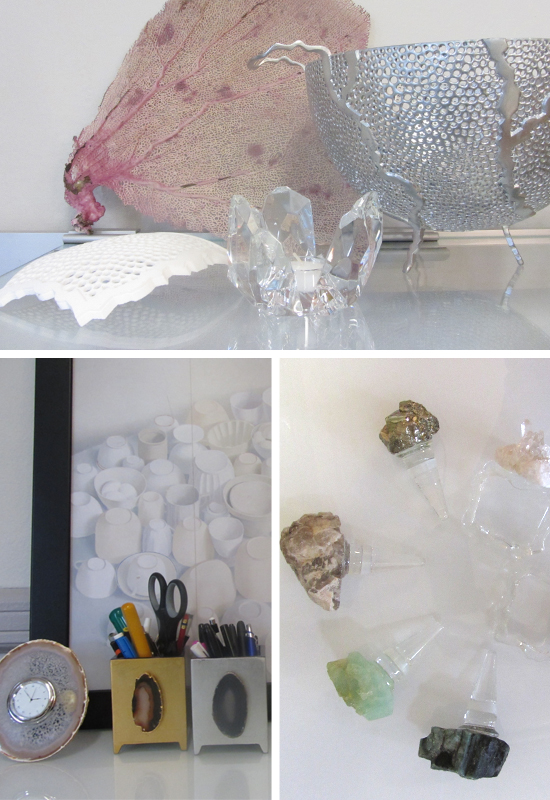
Around the Office: prototypes, Anna’s desk, agate bottle toppers and napkin rings
What is your secret to time management?
I like to close my laptop so I can focus without the distraction of email. But sometimes there are a lot of immediate concerns that punctuate the rest of my work. That is the nature of design and being in New York, and that is OK too. The design process is really circular — an expectation that things will work in an orderly fashion is unrealistic. We turn back to original decisions over and over again.
Where does collaboration come into play in your work?
RabLabs is a small business and time is precious so I really enjoy collaboration. My distributor and I were sharing ideas earlier this week about the work flow when a shipment came in from Brazil. Clients have great suggestions about what they want to see. I collaborate with my photographer on photo shoots. All the relationships I have are intended to be in that fashion. There is a lot we can all learn from each other because everyone has different competencies and perspectives.
How do you recharge your creativity?
I love to watch Bollywood movies. I find them to be very over-the-top, visually spectacular and super absorbing. They’re also extremely romantic.
Design Inspiration: a collection of toothbrushes from around the world, Espera sea fan colander, rock samples
What was the toughest lesson you learned as a young designer?
I’ve learned over the years that it is not always possible to produce everything that I dream about. I can draw something beautiful of something that you think should come to life, but it may be impossible to fabricate, or would take an unrealistic amount of time. Before I understood the intricacies of fabrication, I thought that all I had to do was be stubborn and tenacious in order to get things made.
How do you decide when it is time to celebrate a small victory?
What I get most excited about is when parts get back from the manufacturer. That is when I feel like I have accomplished something and I am creating. I get excited too when we are in magazines, that’s always fun.
Is there a quote that keeps you moving forward?
Being a designer means looking closely at the world around us for inspiration and realizing that the things around us are really magical. Using the inspiration that surrounds us, we have the ability to make magic with our designs.
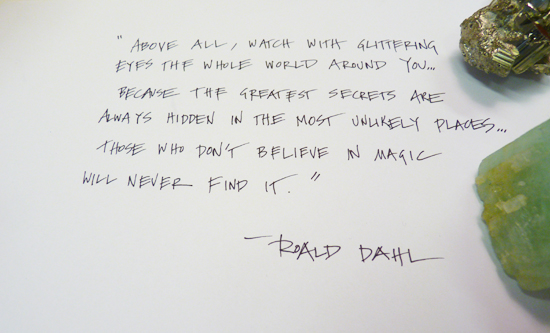
What new skills are you learning at the moment?
I am learning a lot about crystal manufacturing for my newest designs. I’m learning a lot about the production parameters and how these pieces are made. Back to my biological inspiration for these pieces — if you understand how something forms in nature then you can understand how to fabricate something in a similar fashion, because it references the origin of the piece.
What advice would you have given yourself 5 years ago?
I would have gotten more help and hired people sooner. For many years it was just me and an excellent operations manager, Janelle, and a Brazilian manufacturing specialist, Renata, both of whom worked remotely, until I started hiring interns and a designer, Kevin. Support is very important, even back when I started the business in my 91-year-old grandma’s basement. In those years, she was in charge of all the UPS shipping and she and my mom even helped to assemble the products!
The advice I give my students is to take wild chances and not to play it safe with their ideas. School is a time for exploration and openness.
With Valentine’s Day coming up, I asked Pancake Plate designer Jon Wye a few questions about his new dishware, which conveniently come packaged as a set of 2.
Me: What’s your favorite kind of pancake?
Jon: Uhhh, that’s like asking who is your favorite child. It’s hard to imagine you have a favorite, but you know you do. Mine is Banana pancakes, followed by banana chocolate chips pancakes, followed by banana chocolate chip blueberry pancakes. Little tip, don’t mix the banana slices in with the batter. Place them on the pancakes on the grill once the batter has been slightly set, so when you flip the pancakes it pan fries the bananas and they caramelize. It’s makes the pan really messy but it’s well worth it.
Me: Grade A or Grade B maple syrup?
Jon: Grade B syrup hands down. It’s actually got a stronger flavor and is a thicker syrup. Grade A is good, but it’s usually thinner and I think tends to soggy the pancake more quickly. And I definitely stay away from the cheap stuff, which is usually just flavored corn syrup.
Me: Could you recommend pancake etiquette for a date?
Jon: I think you mean pancake etiquette for the morning after! [Editor’s note: He’s single, ladies!] But simple answer, make the pancakes from scratch. That little extra bit of labor shows you care.
Me: And caring is the reason for the season.
Alright readers, can you help suggest a great pancake date for Valentine’s Day?
According to artist Jamie Cornett, there’s an ongoing joke among musicians; when they get frustrated with practicing or tired of music in general, they say they’re going to turn their instrument into a lamp. Jamie wasn’t frustrated or fed up with music, but he was intrigued by the lamp idea.
“I realized that there are so many instruments, beyond their playing years, that sit in closets and attics,” he says. “They didn’t even get to become lamps! It’s my goal to find them and turn them into displayable pieces of functional art.”
Although he calls his first attempt at lamp-making “a horrible disaster,” he still uses his first lamp in his home today. “I had no idea what I was doing. I created it using the wrong tools, and too much glue! But I love it because it reminds me of the original idea and allows me to reflect on how that idea has become something that I’m really proud of,” he says.
Jamie’s lamps are definitely something to be proud of. He has improved his technique, refined his skill, and perfected his tools since. Now, his creations are not only working lamps, but also beautiful works of art.
Of course, Jamie doesn’t always have an attic full of instruments. In fact, he works from his New York City apartment. So, he scours estate sales, pawn shops, and online auction sites for trumpets, clarinets, and flutes that have played their last notes. “I’m not ashamed to admit that at least one [instrument] has come from the streets of NYC on trash day,” he tells us.
While these woodwind wonders and brass beauties won’t be making melodies in the future, they are making people smile. “These lamps are the perfect gift because you can’t look at one without reacting in some unexpected way,” Jamie explains. “They remind people of their favorite jazz piece or hours spent in a practice room preparing for an audition. Each one has the ability to make you feel like it was made with just you in mind.”
For years, Los Angeles designer Lesley Anton used her empty honey bear bottle to hold dish soap at her kitchen sink. Her clever, eco-friendly idea led to the creation of cast porcelain Honey Bears, paying homage to what Lesley describes as an “iconic form that embodies the American kitchen.”
I was so inspired by Lesley’s dish soap idea that I looked up a few more uncommon uses for the sweet, sticky substance. I am a honey enthusiast. I take on the philosophy of Buddy the Elf: smearing it on toast, on pancakes, in tea, on apples, on peanut butter sandwiches, in lemonade, in cupcake recipes, on a spoon, through a straw. I thought it might be nice to incorporate honey into other domestic situations. Here are nine alternate uses for the iconic honey bear:
Skin moisturizer Mixed with eggs and flour, honey can cure dry winter skin. Add sugar and you have a cake!
Antiseptic When the glucose in honey is diluted in water or body fluids, hydrogen peroxide is gradually released. So dabbing some honey on a wound will not only keep it clean, but it will also prevent a bandage from sticking to the sore.
Energy booster When glucose is absorbed by the brain it reduces fatigue, so add some honey to water to create a quick and natural energy drink after a long night out.
Burn relief Honey has been known to sooth the sting in sunburn and other minor burns. Mix honey with petroleum jelly to create a cooling post-beach lip balm.
Hangover cure In case you weren’t impressed enough with the amazing glucose in honey, it also speeds the metabolism of alcohol, making a hangover pass more quickly.
Stain remover Honey can stand in as a pre-wash stain remover for fruit stains.
Hair conditioner Honey can clear buildup without stripping hair of its natural oils. It will also form a protective layer on hair preventing damage from styling products and other elements. Adding honey to some olive oil and buttermilk will make it easier to use.
Antifreeze Honey will not freeze but also has a considerably high boiling point so it will not evaporate, making it beneficial as antifreeze in the winter as well as in the summer. Some brands of antifreeze also choose to add honey as a thickening agent to coat the pipes of a radiator.
Golf balls Inside every golf ball is a smaller rubber ball filled with liquid. Up until the 1960s, that liquid was honey but has recently been replaced with a synthetic liquid with similar properties.
Who knew there were so many other uses for my favorite condiment? I was hoping it could be used to clean the drool off my keyboard. Will you be trying any of these natural home remedies?
info sourses: Life Hackery, Grandma’s Craft Guides, Modern Mechanix
Looking for a new look for the new year? Why not try a style that incorporates reclaimed wood into modern fashion? David Steinrueck’s creative ties are a clever way to celebrate living against the grain.
David took a moment to tell us about his design inspiration, finding salvaged wood in the San Francisco area, and how to wear a wood tie with any outfit.
Q: How did you get the idea to create ties made out of wood?
I started Wood Thumb with my brother Chris in January of 2011. We wanted to prove that with a little bit of community support and minimal funding, a craft can be turned into a thriving company. The wood tie was designed to allow unconventional people to stand out from the crowd and make a bold statement to the world.
Q: Why reclaimed wood? Is it difficult to get the type of wood used to make the ties?
We use reclaimed materials in part due to our belief in zero waste products and also because of the incredibly beautiful wood we were able find in salvage yards around our area. We are lucky enough to live in an area of the country where we can track down an abundance of old redwood that we are able to use in our process. By using reclaimed wood, we offer every customer a unique product, each with its own special past life.
Q: How do you recommend wearing a wood tie? Casual with jeans? As part of the formal look with a suit?
There are many ways to rock a wood tie:
The Tech Slacker – Wears her tie to the office with a t-shirt, jeans, and a pair of New Balance shoes.
The Urban-Eco – Wears his tie with a worn collared shirt, khakis and hiking boots or sandals.
Center of the Club – Wears his tie with a bright collared shirt, a blazer, dark shades, and dress shoes. Bottle service.
The Mission – Wears her tie with 1950s collared shirt, skinny jeans, and sneakers.
Q: Did you expect such a great response to your unique design?
The very first tie we made was received with excitement from everyone we showed. We have grown our production from 50 ties/week to 500 ties/week and we are still not able to keep up with our current demand. Nonetheless, I am still astounded every day that so many people are enjoying the work and craft that we put into each tie.
Thanks, David! We love the suggestions on how to rock a wood tie! We’d love to hear more ways to jazz up outfits with offbeat accessories. What’s your favorite uncommon statement piece?
Want great music recommendations? Ask the man who’s literally in the music business. Jeff Davis, the artist behind the popular record bowls, clocks, coasters, and bookends, knows his albums.
Right now, it seems like everyone‘s weighing in on their favorite songs, albums and music videos of the year. NPR seems to have had a year-long love affair with Adele, promoting her album during every seasonal pledge drive. My favorite music blog, KEXP out of Seattle, turned over the picks to their DJs and ended up with something closer to a top 500. There’s no shortage of great music reviews at this time of the year. I decided to check in with Jeff to get a more timeless perspective.
Q: What are the top 10 albums you love too much to use in your homewares?
A: 1. “Them” – featuring Van Morrison
2. “Unicorn” – Tyrannosaurus Rex
3. “The Low Spark of High Heeled Boys” – Traffic
4. “Babylon By Bus” – Bob Marley and the Wailers
5. “Blues for Allah” – The Grateful Dead
6. “A Monastic Trio” – Alice Coltrane
7. “The Blues” – Nina Simone
8. “On the Beach” – Neil Young
9. “5” – J.J. Cale
10. “What’s Going On” – Marvin Gaye
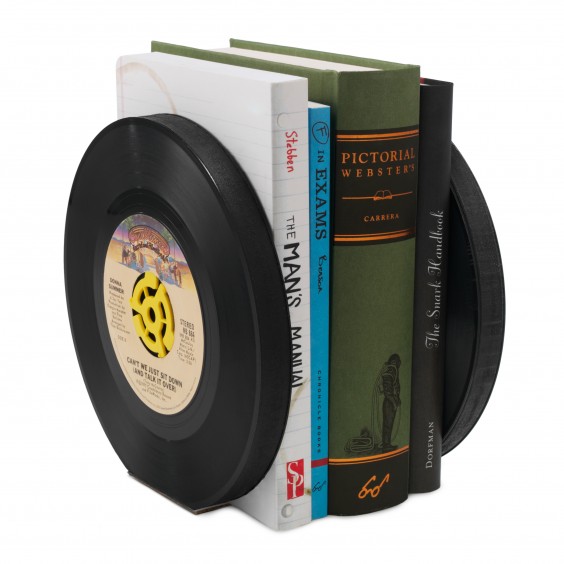
Q: What was your first record?
A: “Saturday Night Fever” – soundtrack
Q: Wow! Well… What’s the best new album of 2011?
A: “The King is Dead” – Decemberists
Isn’t it amazing how our tastes all grow and change? I’m not ready to publicly admit the first album I ever bought.
But I agree with Jeff that the Decemberists put out a great album this year. David Foster Williams fans may see some familiar references in their single, “Calamity Song.”
Q: Last question. Will people ever nostalgize tapes or CDs as much as they do records?
A: Not likely. Records have been popular from the 1950s till the present. No other recorded music medium has as much iconic meaning or connection as records.
That, and I’d challenge anyone to figure out how to turn a flimsy CD into bookends!
Thanks to Jeff for sharing some great music with us. What were your favorite songs and albums from 2011?
I’m putting together my New Year’s playlist, so please share links below!
Artist Melanie Mckenney creates earthenware bowls that bear a stunning resemblance to fruit and vegetables. Her bowls are designed to look like the ingredients in a fresh salsa with realistic colors and the textures and details on her newer Grapefruit and Canteloupe bowls will fool the eye into thinking they are the real thing.
The life-like outcome of her work is not a coincidence. “By translating nature’s designs into clay I am able to invoke a new appreciation for everyday objects. Fruits and vegetables have such a variety of shapes, colors, and textures. By casting directly from the actual fruit or vegetable, I am able to replicate these designs in each bowl.”
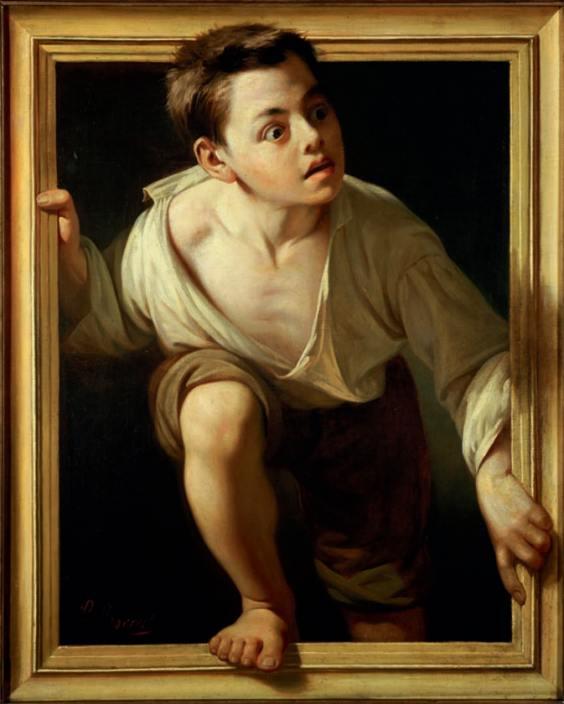 (Escaping Criticism by Pere Borrell del Caso. source Wikipedia)
(Escaping Criticism by Pere Borrell del Caso. source Wikipedia)
For centuries artists have been attempting to fool the eye with life-like painting and sculptures. In ancient Greece contests were held between artists to see whose paintings were more realistic. One famous contest featured a painted curtain so convincing, a rival artist attempted to draw them back.
The Renaissance brought a better understanding of perspective drawing and a term for art that fools its viewers- trompe l’oeil, which means “deceives the eye” in French. Subjects walked out of paintings and houseflies rested on canvas art. On a larger scale, frescos were painted on the ceilings of buildings giving the illusion of staring up to the sky through a window: an art form named di sotto in su, translating into “from below, upwards” in Italian.
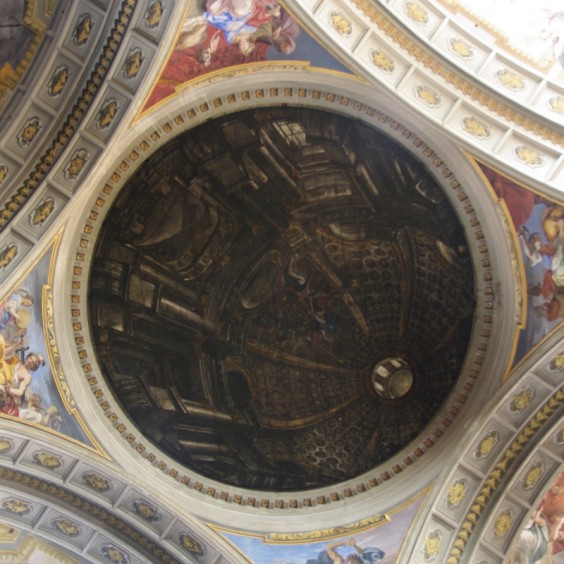 (Trompe L’oeil, genevieveromier)
(Trompe L’oeil, genevieveromier)
More recently a modern and reversed version of di sotto in su has emerged in urban environments that are making passers-by look down. Artists are creating 3D images on the sidewalk in chalk and paint to deceive city dwellers into the thinking the ground beneath them has opened up.
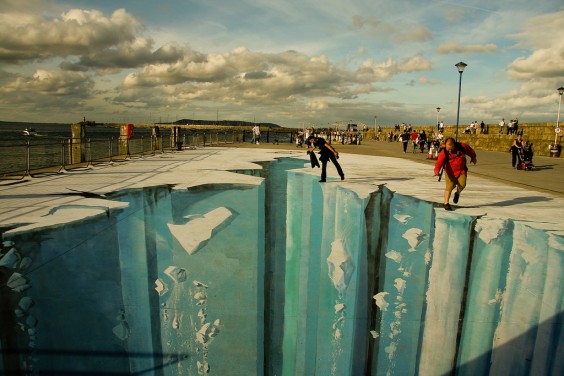 (on the very edge of a 3D illusion, calliope_Muse)
(on the very edge of a 3D illusion, calliope_Muse)
Perhaps the most popular examples of trompe l’oeil in our society are wax figures of our favorite entertainers. Commissioned during the French Revolution to recreate the forms of famous leaders, Marie Tussaud’s death masks of the French royal family were paraded as flags after their executions. In 1802, she moved to London with her family where she opened a public exhibition space. Today, Madame Tussaud’s wax museums are huge tourist destinations in big cities internationally.
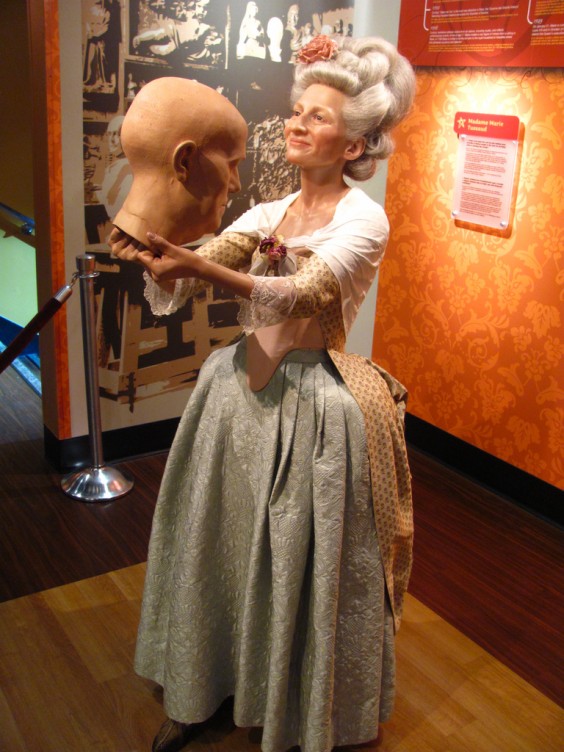 (Madame Tussaud’s figure at Madame Tussaud’s Hollywood, Loren Javier)
(Madame Tussaud’s figure at Madame Tussaud’s Hollywood, Loren Javier)
Throughout time artists have created such realistic works to display their understanding of forms and perspective or to trick their audience. Why does Melanie try to fool you? Melanie says that in creating life-like pottery, she “aims to promote local farming, healthy eating, as well as an appreciation for handmade functional housewares”.

